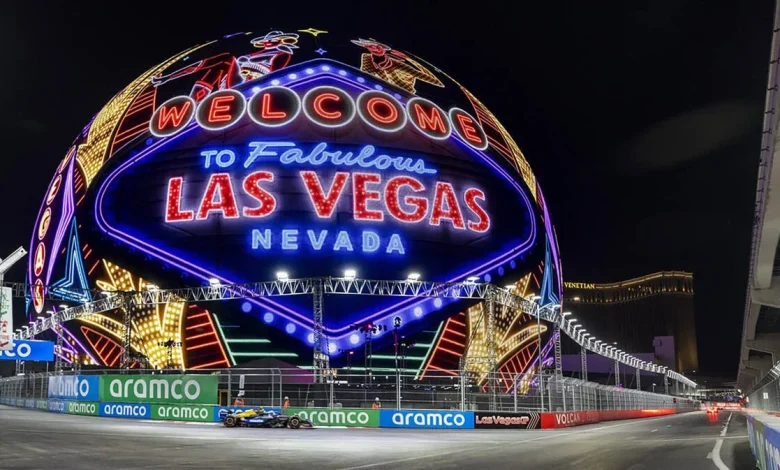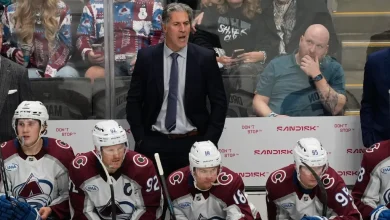F1’s plan after 2024 Vegas GP sales dip: Go bigger, cheaper and ‘make a splash again’

Since returning to the Formula One calendar in 2023, the Las Vegas Grand Prix stands out for doing things a bit differently — from the Saturday night race start time, ensuring the race pops against the city’s famed skyline, to shutting down the Strip to form part of the track. The first two years of the race have been enormous undertakings.
But ahead of its third running, there’s an extra challenge facing one of F1’s most hyped-up events: the decline in tourism that Vegas has faced this year.
In September, the Las Vegas Convention and Visitors Authority (LVCVA) noted an 8.8 percent drop in visitors compared to 2024. This followed an 11 percent year-on-year drop in June, which the LVCVA said in a statement reflected “the broader backdrop of persistent economic uncertainty and weaker consumer confidence.”
Emily Prazer, F1’s chief commercial officer and president of the Las Vegas GP, said last month that ticket sales are about 50 percent higher than at this time in 2024. Last week, a spokesperson for the LVGP confirmed to The Athletic that the 2025 race is “still pacing well for a sell-out.”
The LVGP organization had slightly different objectives in each of its first two years.
The project’s 2023 debut turned plans for the race into a reality just 18 months after the event’s announcement, complete with a hefty dose of glitz. The remit from Liberty Media, F1’s commercial rights owner, which also promotes the race, was to put on “the show of all shows,” according to Prazer.
Year two was about accessibility and closer work with the local community, following frustrations in 2023 over ticket pricing and disruption caused by the track build and the on-track schedule.
But both events were enormous commercial successes. A study from Applied Analysis, an economic analysis and consulting firm, claimed the grand prix is now the largest annual event in Las Vegas.
“We’re making a splash again,” said Prazer of year three.
Part of this push centers on the entertainment programming around the on-track action, which leans into Las Vegas’ reputation for showmanship. It is also aimed at improving ticket sales for the 2024 race, which were lower than anticipated. F1 reported a weekend attendance of 306,000 last year, down from 315,000 in 2023. Although F1 has made a big impression since returning to Vegas for the first time in 41 years, it hasn’t been perfect.
“(There will be) just constant entertainment,” Prazer said. She explained that this year’s race draws on Las Vegas’ arts scene, bringing performers from various local shows into the race environment who will appear throughout the weekend. And, although there won’t be a repeat of the drivers’ parade from the Miami race in May, where the F1 racers drove full-size Lego cars around the track, Prazer hinted that they are planning something Lego-related for Vegas, too.
The LVGP has also established a new business forum event on Thursday, while F1 Academy, the all-female racing series, will race on F1’s undercard.
“How do we make Vegas feel like a Super Bowl week?” Prazer said. “It just feels like there’s stuff happening 24/7. I think what we’ll find is that it feels a lot more compressed, but there’s just entertainment going on from the minute everyone wakes up through to the post-race parties and stuff like that.”
The grand prix on Saturday night will now start two hours earlier than previous years, at 8 p.m. PT. This change came in response to paddock criticism of the late scheduling, which will also shift the rest of the race weekend schedule.
Practice on Thursday and Friday will begin at 4:30 p.m. local time, coinciding with sunset. “It’ll be interesting to see what it looks like during the day, which I obviously have heart palpitations over,” Prazer joked. “It dings at night. You don’t typically really see Vegas during the day.”
The LVGP has changed its ticket offerings again for fans entering year three. This includes making single-day tickets available from the start of the sales period. Prazer admitted that when this started in 2023, the idea was to “lean in heavily on ultra-high net worth (individuals) and the huge whales that come in to gamble” by focusing on high-end hospitality and pricing.
The race organizer discovered greater demand than expected from both the domestic U.S. audience and individuals seeking more reasonably priced experiences to sample both F1 and Vegas.
“You can buy your $25,000 really expensive ticket for your high-roller, but there is entry-level pricing,” Prazer said. “On Thursday night, you can come for $50. We want to make sure there’s something for everyone, and then keep Saturday night as the pinnacle of entertainment and, obviously, racing.” The $50 tickets for the Flamingo Zone – located close to Turn 5 on the track’s layout – are now sold out.
Another criticism leveled against the LVGP, especially during its first year, was the disruption the race caused for locals working along the Strip during required repaving for the track’s construction.
Since the roads did not need repaving again in 2024, the installation work required fewer days, and track build times have also fallen year on year.
The team has now reduced the 10-day job of building the required bridges over the track in 2023 to five days. Unlike street tracks like Singapore or Jeddah, which can keep their roads shut for days around the grand prix, Vegas opens and closes its roads every three hours to keep people moving.
Prazer claimed that local sentiment was “a million times better” than when the race started, as communications have improved around planned works, as well as F1’s year-round presence in Vegas via its Grand Prix Plaza site. This includes the pit lane and paddock area. The complex now has a go-kart track, a 4D theater, and private event spaces.
The owner of a restaurant that last month agreed to drop a lawsuit related to the 2023 Vegas race nevertheless claimed that even a reduced disruption for the race build-up remains a concern for both local business and their clientele.
“When they (tourists) come to Vegas three, four months prior to the race, it’s not Vegas. It’s not what Vegas is about,” said Gino Ferraro of Ferraro’s Ristorante in the Las Vegas Review-Journal. “You get in a cab ride for an hour to get a mile, mile-and-a-half, and pay $70 or $80 instead of paying $10 or $15. Then every reservation is late, and they call us and say, ‘We’re stuck in traffic.’”
Ferraro also said he would have to temporarily close his restaurant due to the earlier race start time.
Looking beyond the 2025 race, F1 and the casinos that support the event have recently emphasized their long-term commitment.
Earlier this year, Prazer said they’d collectively agreed to continue for two years beyond 2025, and there were also additional, longer-term agreements in place with various partners. For example, Clark County’s approval for the grand prix to take place runs through to 2032.
“It’s well-documented how much money we’ve spent on this project, so we have no desire not to be there for the foreseeable future,” said Prazer. On this, F1 has spent more than half a billion dollars establishing the race to this point.
“Hopefully, everyone sees that it is growing into a really spectacular event on the calendar.”
The main event at the LVGP is always going to be what happens on the track. The long straights and cool conditions have combined in years one and two to provide plenty of racing action and overtaking. Both editions of the race so far were among the most exciting of their respective seasons.
Against the context of a three-driver fight for the world championship in 2025, this year’s running has plenty of potential to deliver on track again. But if year two was about scaling back, then year three will see F1 turn the dial back up on making the grand prix fit Las Vegas.





